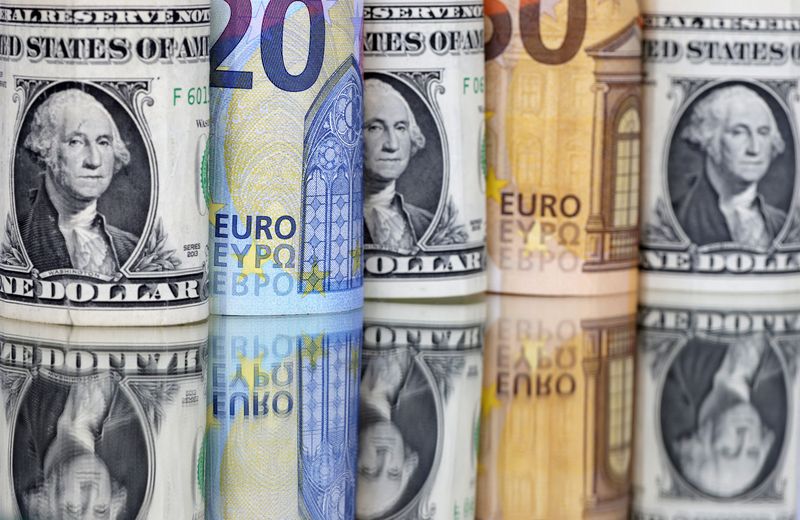Forex
Dollar picks up steam; yen falls past 149 per dollar


© Reuters. FILE PHOTO: U.S. Dollar and Euro banknotes are seen in this illustration taken July 17, 2022. REUTERS/Dado Ruvic/Illustration/File Photo
By Samuel Indyk and Brigid Riley
LONDON (Reuters) -The U.S. dollar rose on Thursday but held below a 12-week high reached earlier in the week, as traders digested comments from policymakers in the previous session that suggested rates would remain higher for longer.
On Wednesday, several Federal Reserve speakers gave a range of reasons for feeling little urgency to start easing policy in the United States soon, or to move quickly once they do.
“Central banks need to be convinced that, not only will inflation come down, but that it will stay down,” said Colin Asher, senior economist at Mizuho.
The market is pricing in around a 20% chance the Fed will begin to cut rates in March, down significantly from the start of the year, and around a 60% chance of a 25 basis point cut in May, according to CME Group’s (NASDAQ:) FedWatch Tool.
The was last up 0.2% at 104.23, having reached 104.60 on Monday, its highest level since November 14, propelled by Friday’s blowout jobs report.
“Now that the dust has settled on non-farms, I think what we are seeing is a recalibration of the rates outlook through to next year which has lifted the dollar into a range that is a level higher,” said Kyle Chapman, FX markets analyst at Ballinger & Co.
Higher U.S. Treasury yields have boosted the dollar, particularly against lower-yielding currencies, such as the yen.
The yen was last down 0.7% versus the greenback to 149.18, its weakest level since November 27.
Bank of Japan Deputy Governor Shinichi Uchida said the central bank was unlikely to raise interest rates aggressively, even after exiting negative interest rates.
“Given that we see UST yields higher in the near term, we see remaining elevated,” Mizuho’s Asher said.
“Any decline will likely need to wait until closer to the March BoJ meeting. We see April as the more likely timing for a BoJ move and thus a better time to look for USD/JPY to move lower.”
The euro was down 0.1% at $1.0761, holding above its lowest level since Nov. 14 at $1.0722 hit on Tuesday.
Sterling was down 0.2% at $1.2602.
The yuan held steady despite data that showed China’s consumer prices fell at their steepest pace in more than 14 years in January.
CPI fell 0.8% in January from a year earlier, but rose 0.3% month-on-month, data revealed. Economists polled by Reuters had forecast a 0.5% fall year-on-year and a 0.4% gain month-on-month.
“We expect the Chinese authorities to favour maintaining stability in the yuan going into the Lunar New Year holidays, with dollar/onshore yuan likely to remain within the 7.18-7.22 range for now,” said Wei Liang Chang, currency and credit strategist at DBS.
The currency got support as China’s stock market stabilised following the appointment of a new securities regulatory head, buoying sentiment despite the disappointing data.
The offshore Chinese yuan was mostly flat at 7.2169 per dollar, while the stood at 7.1970.

 Forex3 years ago
Forex3 years agoForex Today: the dollar is gaining strength amid gloomy sentiment at the start of the Fed’s week

 Forex3 years ago
Forex3 years agoUnbiased review of Pocket Option broker

 Forex3 years ago
Forex3 years agoDollar to pound sterling exchange rate today: Pound plummeted to its lowest since 1985

 Forex3 years ago
Forex3 years agoHow is the Australian dollar doing today?

 Cryptocurrency3 years ago
Cryptocurrency3 years agoWhat happened in the crypto market – current events today

 World3 years ago
World3 years agoWhy are modern video games an art form?

 Commodities3 years ago
Commodities3 years agoCopper continues to fall in price on expectations of lower demand in China

 Economy3 years ago
Economy3 years agoCrude oil tankers double in price due to EU anti-Russian sanctions























